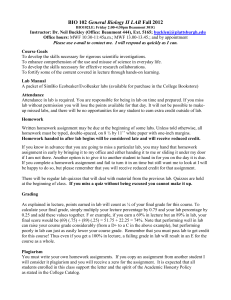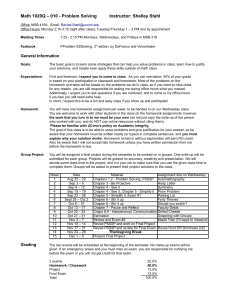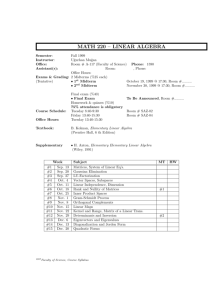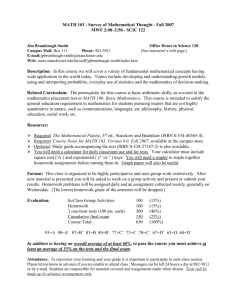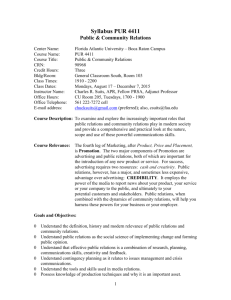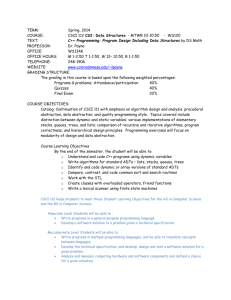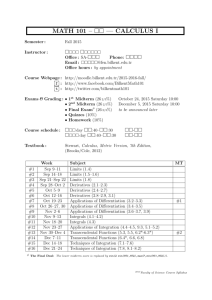EC 307 * Macroeconomics - Rosemary Thomas Cunningham
advertisement
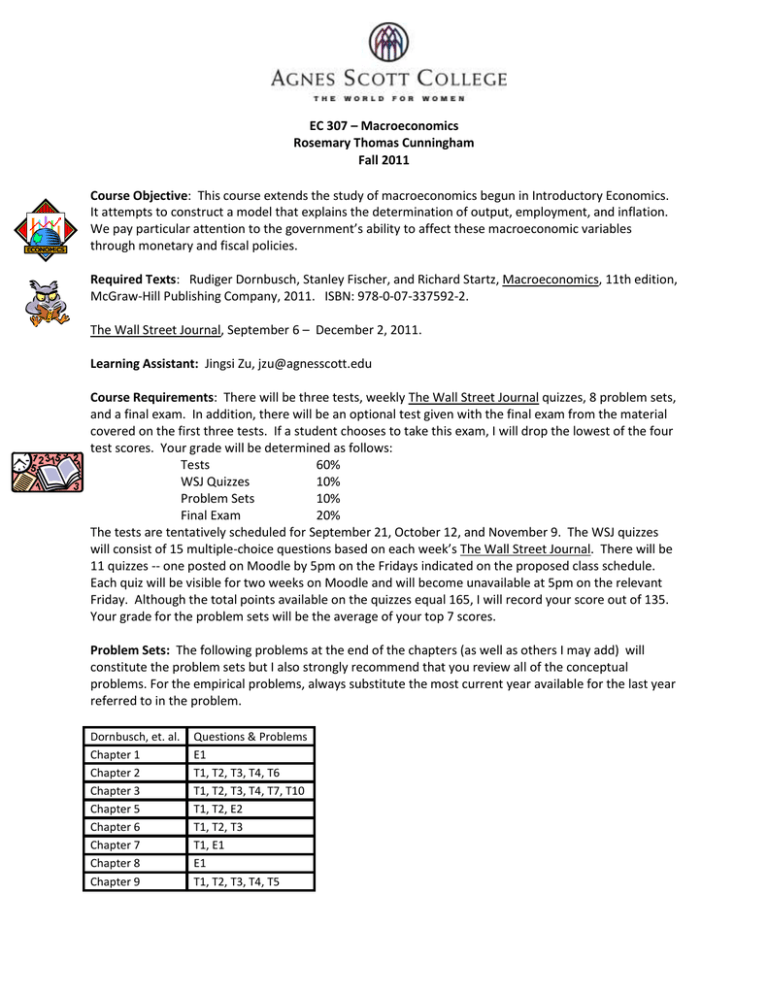
EC 307 – Macroeconomics Rosemary Thomas Cunningham Fall 2011 Course Objective: This course extends the study of macroeconomics begun in Introductory Economics. It attempts to construct a model that explains the determination of output, employment, and inflation. We pay particular attention to the government’s ability to affect these macroeconomic variables through monetary and fiscal policies. Required Texts: Rudiger Dornbusch, Stanley Fischer, and Richard Startz, Macroeconomics, 11th edition, McGraw-Hill Publishing Company, 2011. ISBN: 978-0-07-337592-2. The Wall Street Journal, September 6 – December 2, 2011. Learning Assistant: Jingsi Zu, jzu@agnesscott.edu Course Requirements: There will be three tests, weekly The Wall Street Journal quizzes, 8 problem sets, and a final exam. In addition, there will be an optional test given with the final exam from the material covered on the first three tests. If a student chooses to take this exam, I will drop the lowest of the four test scores. Your grade will be determined as follows: Tests 60% WSJ Quizzes 10% Problem Sets 10% Final Exam 20% The tests are tentatively scheduled for September 21, October 12, and November 9. The WSJ quizzes will consist of 15 multiple-choice questions based on each week’s The Wall Street Journal. There will be 11 quizzes -- one posted on Moodle by 5pm on the Fridays indicated on the proposed class schedule. Each quiz will be visible for two weeks on Moodle and will become unavailable at 5pm on the relevant Friday. Although the total points available on the quizzes equal 165, I will record your score out of 135. Your grade for the problem sets will be the average of your top 7 scores. Problem Sets: The following problems at the end of the chapters (as well as others I may add) will constitute the problem sets but I also strongly recommend that you review all of the conceptual problems. For the empirical problems, always substitute the most current year available for the last year referred to in the problem. Dornbusch, et. al. Chapter 1 Chapter 2 Chapter 3 Chapter 5 Chapter 6 Chapter 7 Chapter 8 Chapter 9 Questions & Problems E1 T1, T2, T3, T4, T6 T1, T2, T3, T4, T7, T10 T1, T2, E2 T1, T2, T3 T1, E1 E1 T1, T2, T3, T4, T5 Page 2 Chapter 10 Chapter 11 Chapter 12 Chapter 13 Chapter 14 Chapter 19 Grading Scale: Numerical Grade 92-100 90-92 87-89 83-86 80-82 75-79 65-74 60-64 57-59 53-56 50-52 Below 50 T1, T2, T3, T5 T1, T2, T3, T4 T1, T3, T4, T5 T1, T2, T3, T4, T5 T1, T2, T3, T5 T1, T2, T5, T6 Letter Grade A AB+ B BC+ C CD+ D DF Moodle: I will update this course’s Moodle website regularly. Students are expected to check that site and their email for messages regarding the course. Policy on Lateness and Absences Lateness: Students should make every possible effort to be on time for class. If a student is late, she should come in quietly and sit as close to the door as possible. She should wait until the end of class to receive anything that was returned or given out at the beginning of class. If a student is more than 5 minutes late, she will be counted as absent. The student is responsible for any missed information. Absences: Attendance at all class sessions is encouraged. If you do not attend at least two-thirds of the classes, you will fail the course. Again, the student is responsible for any missed information. Missed Tests: Only under extraordinary circumstances should a student miss a scheduled test. Minor illness does not prevent a student from taking a test. If a student does miss a test, the make-up test will be the optional test given with the final. If a student misses more than one test without an extraordinary reason, her final grade will be reduced proportionately. A student cannot make up a Wall Street Journal quiz and, for each day late, the score on the problem set will be reduced by 10%. Office: Buttrick G28, Ext. 6208 Appointments: Please make appointments to see me utilizing the New Meeting Request function in Microsoft Outlook. You can view my available times and request a time that is mutually convenient. Please don’t make appointments before 9 AM or after 4:30 PM. To send a meeting request: 1. Go to mail.agnesscott.edu/exchange 2. In Calendar, click New on the toolbar. Page 3 3. 4. 5. 6. 7. In blank next to the Required button, enter rcunningham Click the Availability tab to check my schedule. In the Start Time and End Time drop-down lists, select the appropriate dates and times. In the Subject field, type the meeting's topic. In the message text area, type any message you want to accompany your meeting request, and then click Send. 8. I am sent a meeting request and I’ll send you a response either accepting or declining the appointment. Course evaluation: Your feedback on the course is extremely valuable to the department, the administration, and me. In particular, I take your comments very seriously and use them to improve the course the next time I teach it. You are responsible for completing an evaluation of the course at the end of the semester. I will provide more details later. Ten Tips for Doing Well in Class: 1. Attend class. You can’t just get the notes. 2. Buy the correct editions of the books. The cost of the books is small in comparison to the cost of your education. Why let $100 ruin your $20,000 semester? 3. Read the sections of the book prior to class, as well as after class. 4. Arrive early to class. This will give you time to review your notes and prepare mentally for class to begin. 5. Unless it’s an emergency, don’t leave class. 6. Take notes! Professor Zavodny has a t-shirt that says, “If I’m talking, you should be taking notes.” 7. Ask questions. If you have a question, ask it as soon as possible. Ask questions in class, in my office, to the tutor, or in the Math and Economics Learning Lab. 8. Work on all assigned questions, practice tests/questions, and end-of-chapter questions as the semester progresses. When you encounter a problem, see tip 7. 9. When preparing for a test, ask yourself “If I was the professor, what would I ask on this test?” 10. Attending college is a full-time job. You should be allocating at least 40 hours per week for your studying. Since the normal course load is four classes per semester, you should allocate 10 hours per week to each course. This means spending 7 hours per week on each course in addition to class time. Page 4 Proposed Class Schedule Week 1 Monday Wednesday Friday Aug 24 Aug 26 Tour of the Economy Sep 1 2 Aug 29 First Day of Class Aug 31 3 Introduction Chapter 1 Sep 5 Natl Income Accounting Chapter 2 Sep 7 Natl Income Accounting Chapter 2 Sep 9 4 Labor Day No Class Sep 12 Growth Chapter 3 Sep 14 Growth Chapter 3 Sep 16 5 AS & AD Chapter 5 Sep 19 AS & AD Chapter 5 Sep 21 AS & AD Chapter 5 Sep 23 Review for Test #1 Test #1 6 Sep 26 Sep 28 Aggregate Supply Chapter 6 Sep 30 7 Aggregate Supply Chapter 6 Oct 3 Inflation & UE Chapter 7 Oct 5 Inflation & UE Chapter 7 Oct 7 8 Inflation & UE Chapter 7 Oct 10 Policy Preview Chapter 8 Oct 12 Policy Preview Chapter 8 Oct 14 Review for Test #2 Test #2 9 Oct 17 Oct 19 Fall Break No Class Oct 21 10 Income and Spending Chapter 9 Oct 24 Income and Spending Chapter 9 Oct 26 Income and Spending Chapter 9 Oct 28 11 IS & LM Chapter 10 Oct 31 IS & LM Chapter 10 Nov 2 IS & LM Chapter 10 Nov 4 MP & FP Chapter 11 MP & FP Chapter 11 MP & FP Chapter 11 Page 5 12 Nov 7 Nov 9 Nov 11 Review for Test #3 Test #3 13 Nov 14 Nov 16 International Linkages Chapter 12 Nov 18 14 International Linkages Chapter 12 Nov 21 International Linkages Chapter 12 Nov 23 - Nov 25 15 Consumption & Saving Chapter 13 Nov 28 Thanksgiving Break No Classes Nov 30 Dec 2 Investment Spending Chapter 14 Big Events Chapter 19 16 Investment Spending Chapter 14 Dec 5 Review for Final Consumption & Saving Chapter 13
